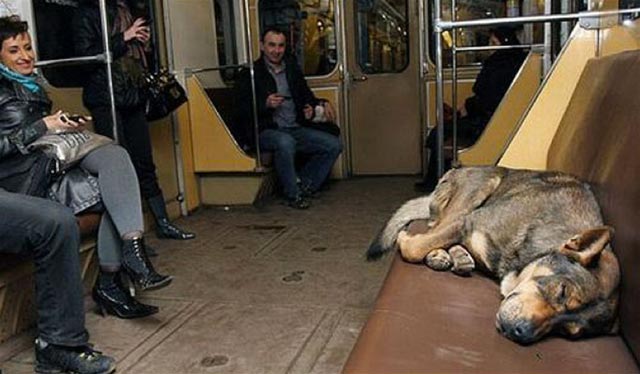 |
| Stray dog commuting in metro image DogFiles |
Each morning, like clockwork, they board the subway, off to begin their daily routine amidst the hustle and bustle of the city.
But these aren’t just any daily commuters. These are stray dogs who live in the outskirts of Moscow Russia and commute on the underground trains to and from the city centre in search of food scraps.
Then after a hard day scavenging and begging on the streets, they hop back on the train and return to the suburbs where they spend the night.
Experts studying the dogs, who usually choose the quietest carriages at the front and back of the train, say they even work together to make sure they get off at the right stop – after learning to judge the length of time they need to spend on the train.
Scientists believe this phenomenon began after the Soviet Union collapsed in the 1990s, and Russia’s new capitalists moved industrial complexes from the city centre to the suburbs.
Dr Andrei Poiarkov, of the Moscow Ecology and Evolution Institute, said: “These complexes were used by homeless dogs as shelters, so the dogs had to move together with their houses. Because the best scavenging for food is in the city centre, the dogs had to learn how to travel on the subway – to get to the centre in the morning, then back home in the evening, just like people.”
Dr Poiarkov told how the dogs like to play during their daily commute. He said: “They jump on the train seconds before the doors shut, risking their tails getting jammed. They do it for fun. And sometimes they fall asleep and get off at the wrong stop.”
The dogs have also amazingly learned to use traffic lights to cross the road safely, said Dr Poiarkov. And they use cunning tactics to obtain tasty morsels of shawarma, a kebab-like snack popular in Moscow.
With children the dogs “play cute” by putting their heads on youngsters’ knees and staring pleadingly into their eyes to win sympathy – and scraps.
Dr Poiarkov added: “Dogs are surprisingly good psychologists.”
By Elaine Furst For Dog Files
| Ken Bell, creator of DogFiles with Max image DogFiles |
Evolution and adaptation
The story is a striking example of the ability of dogs, our trusted friends since prehistoric times, to adapt to changes in human society.
Of course, by selective breeding humans have caused significant changes in the species of dogs (Canis lupus familiaris) both in their physical features (from Chinese Pekingese to Danish dog) and in their functions in cooperation with humans (from shepherds to rescue, from gentle pets to scary military attack dogs).
In contrast to human intervention the Moscow stray dogs described above are themselves adapting to changes in human community in what can only be described as an amazing path to survival.
The fundamental aspect even in the original Darwinian theory of the survival of the fittest and natural selection concentrated exactly on this - the ability of an organism to adapt to changing environment.
Time is way too short to detect physiological changes in Moscow's dogs but one can easily imagine that commuting in trains could also have a selective role in making puppies and in the characteristics they inherit from their parents through genetics. Definitely so the reconsigning of what color of traffic light gives safe passage across the road.
BTW DogFiles site has also a heartwarming report on the decision in Moscow not to implement the plan to deport the stray dogs outside the city. Animal lovers were able to stop this intervention in such a drastic manner in this rather unique society of dogs!
No comments:
Post a Comment